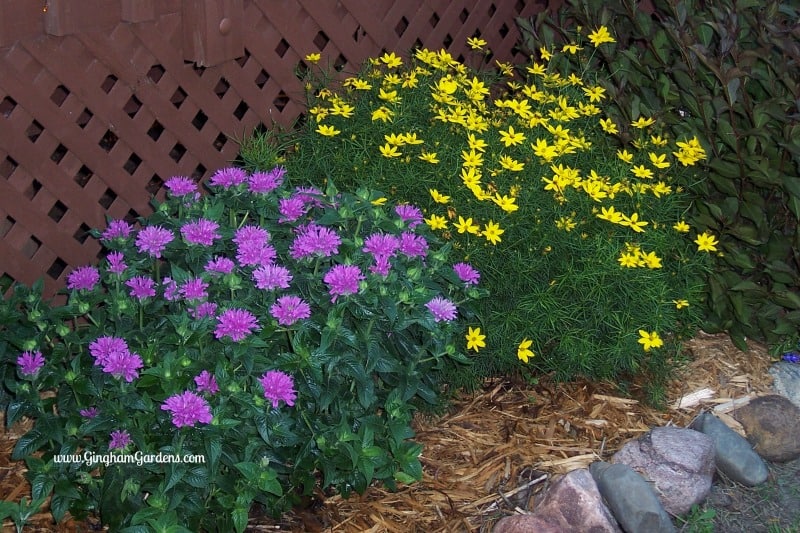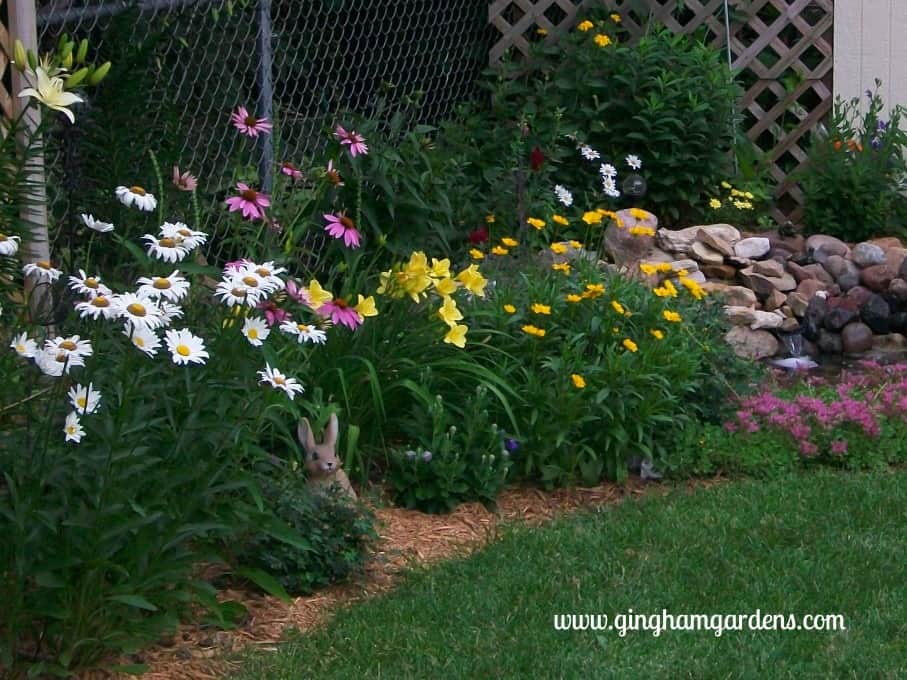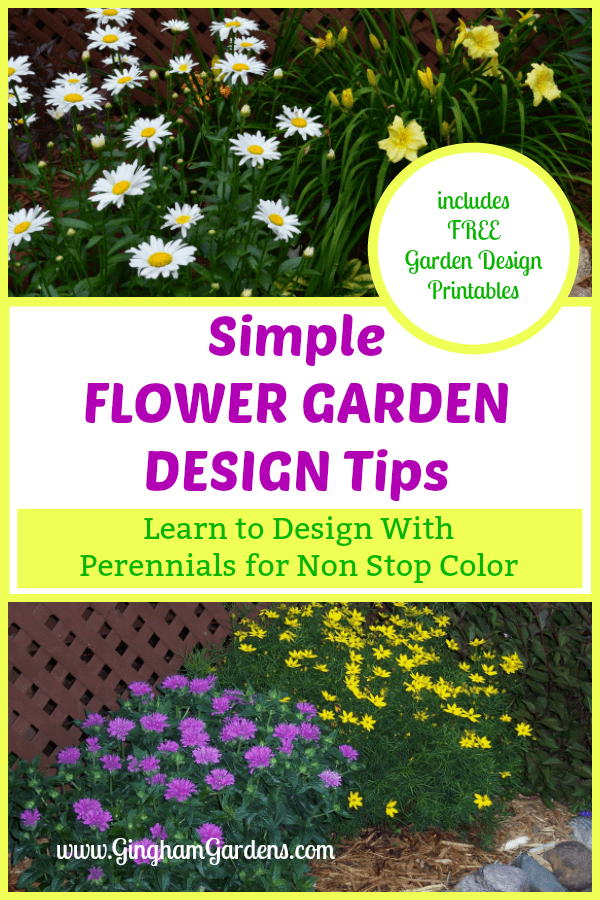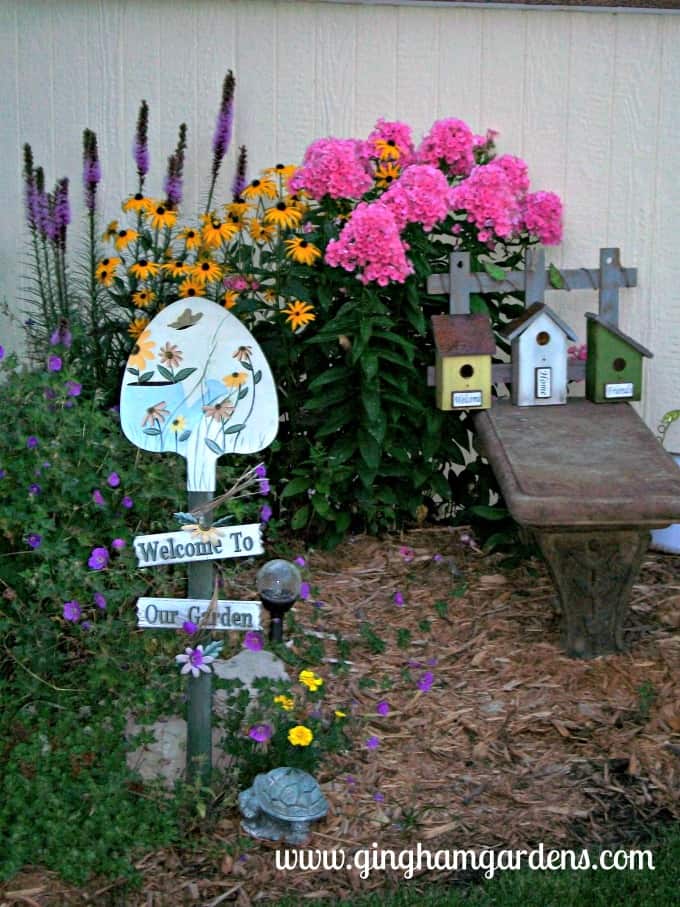Flower Garden Design Tips for the Home Gardener
Whether you’re planning your first flower garden or your fiftieth flower garden, it’s always good to have a design in mind. How do you design your flower gardens – do you sketch them out on paper? Or, do your fly by the seat of your pants? I’ve done it both ways, and I’m always happier with the outcome when I take the time to sketch out a design, or jot down the flower bed ideas that are floating around in my head. You don’t have to be a professional landscape designer to have a lovely flower garden. These Flower Garden Design Tips work for both a new garden or making over an existing flower bed. And, it doesn’t matter if you’re a brand new flower gardener or you’ve been doing this for several years, these tips will help you design a flower garden you will love.
This post contains affiliate links. If you click on
one of the links and make a purchase,
I may receive a small commission at no additional cost to you.
See full disclosure here.
First off, let me say that there is not a right way or a wrong way to design your flower garden. If you love it, well then it’s good enough! Whether you like a cottage-style garden, informal gardens or wildflower or pollinator gardens, if it has flowers, it’s beautiful. I have to remind myself all the time that it’s nearly impossible to create the perfect flower garden, but it’s not impossible to create a beautiful flower garden. A big part of the joy of gardening can be rearranging and working towards perfection. With Flower Garden Design, it doesn’t have to be perfect to be beautiful!
If you are a beginner or you just need some pointers on flower gardening, please take time to read Flower Gardening 101. Also, we won’t be covering sun requirements in this post, but you’ll definitely need to consider this when you’re selecting plants for your flower bed. Again, please check out Flower Gardening 101 if you need help.
Let’s get started with some things to consider when planning out your Flower Garden.
Flower Bed Shape
Questions to consider when laying out your design: What is the shape of your flower bed? Does it border your yard? Will it run along a fence? Does it run along the foundation of your home, garage or a shed? Does it stand on it’s own – like an island or peninsula type bed?
Be sure to add some curves to your flower bed.
Color Combinations in a Perennial Garden
I like to mix things up when it comes to color. Some like monochromatic and that’s super easy, but not my style. When I’m sketching out my plans, I try to pay close attention to what colors I have next to each other. Definitely don’t stress over this. If you end up with three yellow flowers together and you don’t like it, you can always move them around.
If you would like more information on using a color wheel to design your flower garden, we have the perfect article – Winning Color Combinations in a Flower Garden that you will find helpful. With a planning you can come up with the best color combinations for your own garden.
Go ahead and add in annual flowers to your perennial beds.
Plant Placement in a Flower Garden
Stagger your plants. Remember, you aren’t planting vegetables here, you’re planting flowers, so no straight lines.
If you’re working in an island or a peninsula-type bed, you’ll want to plant taller plants in the middle and work your way down with the shorter plants on the outside garden borders. The goal here is to be able to walk around the bed and see all the different plants with none blocking the view of others.
For foundation plantings or border bed, start with your tallest plants closest to the foundation or the back of the border and work your way down with the shortest plants on the outside edges of the bed.
Something to keep in mind when working with perennials is that they don’t reach their full height until their second or third year, and some take longer. Check your plant tag for the height and width of your plant.
When designing a flower bed, arrange the same kind of plant in odd number groupings, or a mass of a single flower type. For instance, planting a group of 3 or 5 pink tall garden phlox all together makes a striking statement in a late summer garden. Continue that idea with different types of plants throughout the rest of your flower bed. Doing this will provide the best visual interest for your flower bed and won’t make it look too jumbled.
Need a Reminder of this Post for Later Reference?
Just pin to one of your gardening boards on Pinterest.
There are more pins to share at the bottom of the post.

Consider Bloom Time When Designing a Flower Bed
Try to spread your plants out according to bloom times. This is probably the most challenging part of flower garden design. To help you with this, I have spent several hours putting together (and updating) a list of over 60 Perennials, which includes sun requirements, and hardiness zones along with some helpful notes. You can get a copy of Designing with Perennials for Continuous Color List in the Gardening Resources Library.
Other Plants and Garden Design Ideas for Your Flower Garden
- Add annual plants and flowers to your design to fill in gaps when you don’t have many perennials blooming and to maintain constant color throughout the growing season.
- To create year-round interest consider adding some evergreens or ornamental grasses to your garden bed.
- Add a flowering shrub or two to your garden design.
- Consider adding evergreen shrubs for year-round interest and much-needed texture.
- If you have the space and the right conditions, what about adding a small tree, like a Japanese maple, to your flower garden.
- Don’t forget to add in bulbs for early spring bloom and color.
Adding Character to Your Flower Garden Design
Be sure to add some finishing touches to your Flower Garden Design, like mulch and garden decor. I love all parts of gardening, but one of my favorite things to do in my gardens is to add character with garden art and decor.
Always be sure to work into your design some solar landscape lights. They create a certain ambiance in your garden when they come on in the evening. And, if you have the space, consider adding a little garden bench. Create a focal point with a piece of yard art or a fountain.
A Few More Flower Garden Design Tips
When you get ready to plant your flower bed, place your plants (in their containers) according to the plan that you’ve drawn out. Now step back and take a look and make any necessary changes. It’s important to remember the plant you buy from the garden center is not full grown, so you can either arrange your plants by the height they will be, or you can arrange them by the height they are now if you’re willing to transplant them in a year or two.
Be sure to take pictures- before, during and lots of afters. It is very gratifying to be able to look back and see how your flower garden has grown and evolved.
I would encourage you to take time, at least every couple of weeks, to take a good look at your garden and make notes on what needs to be moved and any changes you want to make. There are lots of resources in the Gardening Resources Library to help you out with this. If you’d like a little more instruction on starting a gardening journal, check out this post on how to create your own Garden Journal.
And don’t fret too much over your design. The beauty of perennial gardening is you can move most plants if you don’t like where they are. Trust me, I do this a lot. And, as I say, there’s always next year. At the bottom of this post, there is a link to Tips for Transplanting Perennials.
Flower Garden Design Plans
Now that we talked about all the elements to consider when designing a plan for your flower garden, it’s time to start sketching. I’m horrible at drawing, but I’ve found a few inexpensive tools that help. If you have a large garden to design, I really like this 11×17 graph paper. These landscaping templates are a huge help, as well as these french curve ruler templates. When designing your flower bed on paper, its best if you can design as close to scale as possible. Erasable colored pencils are fun to have too.
Over in the Gardening Resource Library (complete the subscription form above to receive your password) you will find a printable – Flower Garden Design Plan that is perfect to use if you’re designing a small garden. There is also an updated list of 60+ Perennials that is organized by sun requirements and zone. Using both of these gardening printables and the tools above, take some time to sketch out your new flower bed, or redesign an existing one. This is an excellent activity for a rainy day, or on your lunch hour, when you can’t actually get outside.
Need more extensive help designing your perennial garden?
flowers blooming from early spring right through fall?
Designing with Perennials for 3 Seasons of Blooms is a Workbook/Guide
to help you create a perennial flower garden that has a succession of
continuous blooms from early spring through fall.
The Guide walks you through each step from designing your dream
3-season perennial garden on paper to executing your plan in the garden.
The Plant Lists in the Guide include over 90 Perennial Flowers
categorized by bloom time, sun requirements, zone, deer resistant,
rabbit resistant, cutting flowers and pollinator friendly.
The Guide is very reasonably priced, so stop and get your copy soon.
Thank you so much for stopping by Gingham Gardens today. I hope you’re inspired to design a new flower garden, or to makeover an existing flower garden. Here are some additional posts to help get you started or for additional inspiration:
Tips for Transplanting Perennials
Designing with Perennials for 3 Seasons of Bloom
Creating & Caring for a Low Maintenance Flower Garden
If you have a gardening question, please leave a comment and I’ll get back to you just as soon as I can. Come back soon!
Happy gardening,
Joanna
More Great Things on Gingham Gardens
Sign up to receive our weekly newsletters full of gardening tips. You’ll also get access to our Gardening Resources Library and all our helpful gardening printables.
More places to find Gingham Gardens:
- Visit Gingham Gardens on Pinterest.
- If you’re on Facebook, Gingham Gardens is also on Facebook.
- Stop by Gingham Gardens’ Amazon store!
- Love Etsy? Come see us on Etsy too.
Save a pin to your gardening board on Pinterest, so you can remember this post later:







